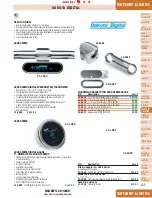
Glossary
WILINK I MODULAR BASE STATION SYSTEM MANUAL
204
OFDM
Orthogonal Frequency Division Multiplexing: A method for multiplexing
signals, which divides the available bandwidth into a series of frequencies
known as tones. Orthogonal tones do not interfere with each other when the
peak of one tone corresponds with the null. The rapid switching, frequency-
hopping technique is intended to allow more robust data service.
OOB
Out-Of-Band
PER
Packet Error Rate. In a digital transmission, PER is the percentage of
packets with errors divided by the total number of packets that have been
transmitted, received or processed over a given time period.
PHY
PHYsical Layer. The physical, or lowest, layer of the OSI Network Model. In
a wireless network, the PHY defines parameters such as data rates,
modulation method, signaling parameters, transmitter/receiver
synchronization, etc. Within an actual radio implementation, the PHY
corresponds to the radio front end and baseband signal processing sections.
PIU
Power Interface Unit
POTS
Plain Old Telephone System. A basic analog telephone equipment.
PSU
Power Supply Unit
PPPoE
Point-to-Point Protocol over Ethernet. PPPoE relies on two widely accepted
standards: PPP and Ethernet. PPPoE is a specification for connecting the
users on an Ethernet to the Internet through a common broadband
medium, such as a single DSL line, wireless device or cable modem. All the
users over the Ethernet share a common connection, so the Ethernet
principles supporting multiple users in a LAN combines with the principles
of PPP, which apply to serial connections.
QAM
Quadrature Amplitude Modulation. A technique used in wireless
applications to double the available bandwidth by combining two
amplitude-modulated signals. The two combined signals differ in phase by
90 degrees; this technique doubles the bandwidth by combining the two
signals at the source before transmission, transmitting digital data at a rate
of 4 bits per signal change.
QoS
Quality of Service. Measure of performance for a transmission system that
reflects its transmission quality and service availability.
QPSK
Quadrature Phase Shift Keying. A data transfer technique used in coaxial
cable networks that sends data using modulating signals. Four different
phases represent data, with each signal’s information determined by the
signal before it. For example, if a phase stays the same from one signal to
the other, the information has not changed.














































